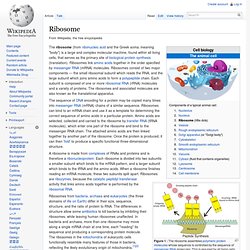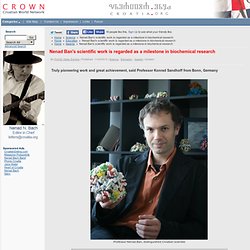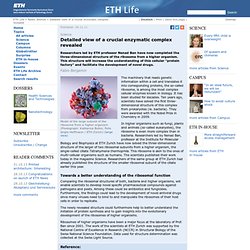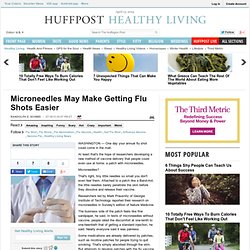

Ribosome. Figure 1 : The ribosome assembles polymericproteinmolecules whose sequence is controlled by the sequence of messenger RNA molecules.

This is required by all living cells and associated viruses. The sequence of DNA encoding for a protein may be copied many times into messenger RNA (mRNA) chains of a similar sequence. Ribosomes can bind to an mRNA chain and use it as a template for determining the correct sequence of amino acids in a particular protein. Amino acids are selected, collected and carried to the ribosome by transfer RNA (tRNA molecules), which enter one part of the ribosome and bind to the messenger RNA chain. The attached amino acids are then linked together by another part of the ribosome. A ribosome is made from complexes of RNAs and proteins and is therefore a ribonucleoprotein. Ribosomes from bacteria, archaea and eukaryotes (the three domains of life on Earth) differ in their size, sequence, structure, and the ratio of protein to RNA.
Discovery[edit] Structure[edit] Nenad Ban's scientific work is regarded as a milestone in biochemical research. Professor Nenad Ban, distinguished Croatian scientist ETH Professor Nenad Ban, Timm Maier, Marc Leibundgut and Simon Jenni (left to right) were so successful with their work on the structural analyses of fatty acid synthases in mammals and fungi that they had two publications in the same issue of "Science".See The architecture of fatty acid factories.

Professor Nenad Ban and his research group - The Ban Lab, ETH, Zurich, Switzerland 2010. Older photos. Thomas A. Steitz with colleagues during the reception at the Royal Swedish Academy of Sciences in Stockholm, 7 December 2009. Detailed view of a crucial enzymatic complex revealed. Researchers led by ETH professor Nenad Ban have now completed the three-dimensional structure of the ribosome from a higher organism.

This structure will increase the understanding of this cellular “protein factory” and facilitate the development of novel drugs. The machinery that reads genetic information within a cell and translates it into corresponding proteins, the so-called ribosome, is among the most complex cellular enzymes known in biology. It has been studied for decades. Ten years ago, scientists have solved the first three-dimensional structure of this complex from prokaryotes (ie. bacteria). They were awarded with the Nobel Prize in Chemistry in 2009.
In higher organisms such as fungi, plants and animals (so-called eukaryotes), the ribosome is even more complex than in bacteria. Is sun exposure a major cause of melanoma? No. Sam Shuster, honorary consultant Author Affiliations sam@shuster.eclipse.co.uk Every summer we are reminded about the dangers of the sun.

Scott Menzies (doi: 10.1136/bmj.a763) argues that the risks of malignant melanoma are real, but Sam Shuster is unconvinced The list of harmful things grows daily, freshly mined by descriptive epidemiology, a substitute for research that confuses association with cause. There is solid descriptive, quantitative, and mechanistic proof that ultraviolet rays cause the main skin cancers (basal and squamous). The melanoma epidemic? Don't panic it's all a terrible mistake. By Professor Sam Shuster Updated: 09:20 GMT, 10 August 2010 Summer is a marvellous time.

It's when we can all enjoy light and warmth, eat gorgeous seasonal foods and get the chance to wear those colourful clothes we've collected during the rest of the year. And, of course, it's also holiday time. Microneedles May Make Getting Flu Shots Easier. WASHINGTON — One day your annual flu shot could come in the mail.

At least that's the hope of researchers developing a new method of vaccine delivery that people could even use at home: a patch with microneedles. Microneedles? That's right, tiny little needles so small you don't even feel them. Attached to a patch like a Band-Aid, the little needles barely penetrate the skin before they dissolve and release their vaccine. Researchers led by Mark Prausnitz of Georgia Institute of Technology reported their research on microneedles in Sunday's edition of Nature Medicine. The business side of the patch feels like fine sandpaper, he said. Some medications are already delivered by patches, such as nicotine patches for people trying to quit smoking.
Disappearing Needles: Vaccine-Delivery Patch with Dissolving Microneedles Eliminates “Sharps” Waste and Improves Protection « Georgia Tech Research News. A new vaccine-delivery patch based on hundreds of microscopic needles that dissolve into the skin could allow persons without medical training to painlessly administer vaccines – while providing improved immunization against diseases such as influenza.

An array of 36 dissolving microneedles is shown here on a fingertip for size comparison. (Click image for high-resolution version. Credit: Jeong-Woo Lee) Patches containing micron-scale needles that carry vaccine with them as they dissolve into the skin could simplify immunization programs by eliminating the use of hypodermic needles – and their “sharps” disposal and re-use concerns. Applied easily to the skin, the microneedle patches could allow self-administration of vaccine during pandemics and simplify large-scale immunization programs in developing nations.
An array of 100 dissolving microneedles is shown here on a U.S. penny coin for size comparison. Writer: John Toon Be Sociable, Share!